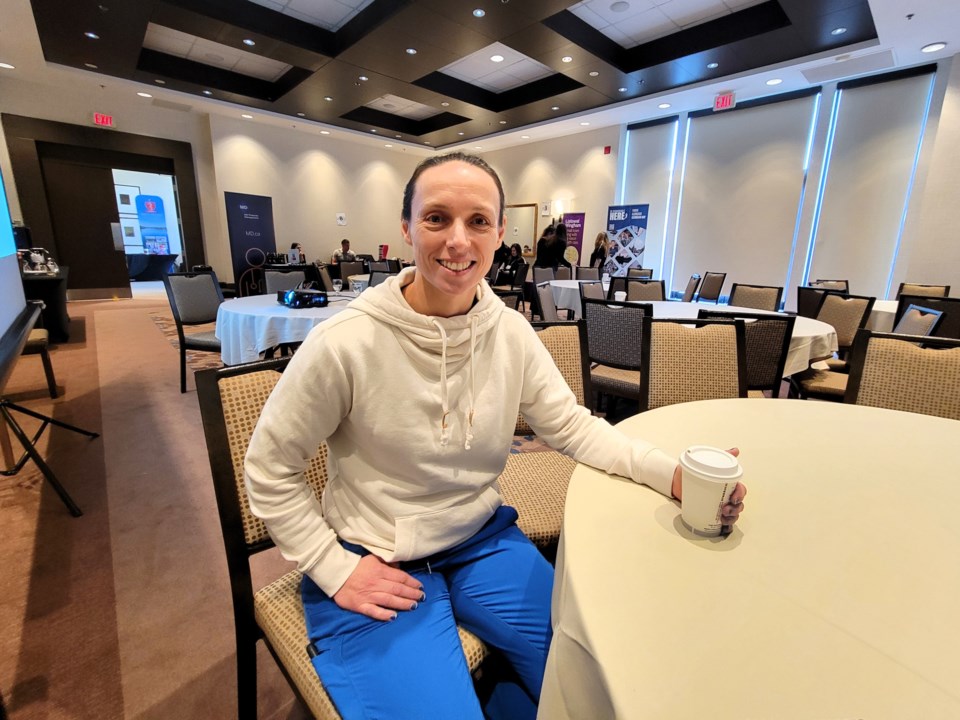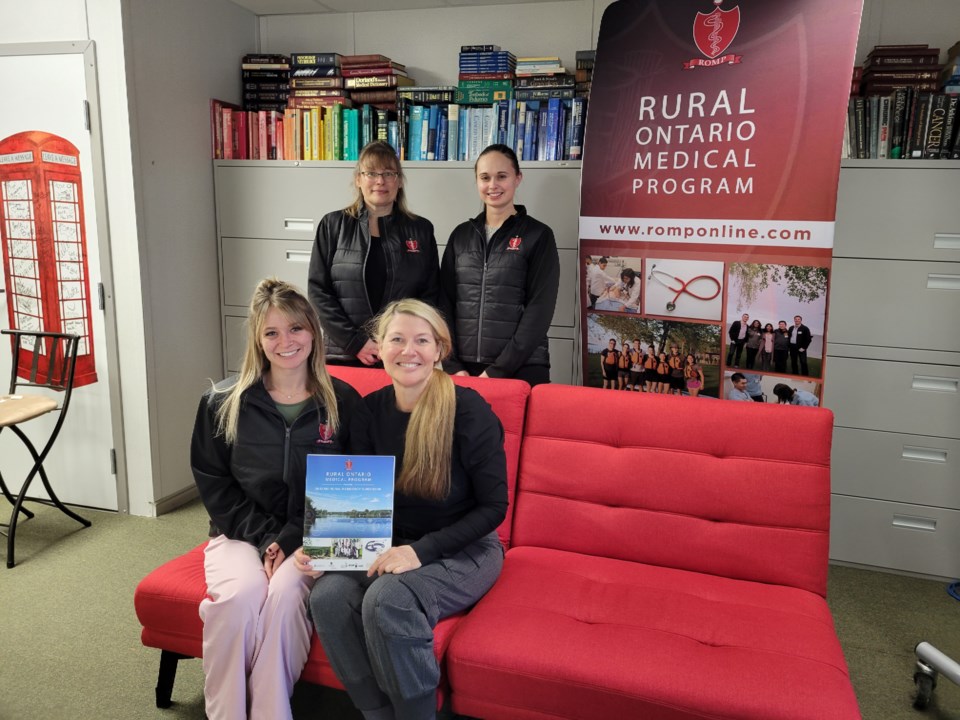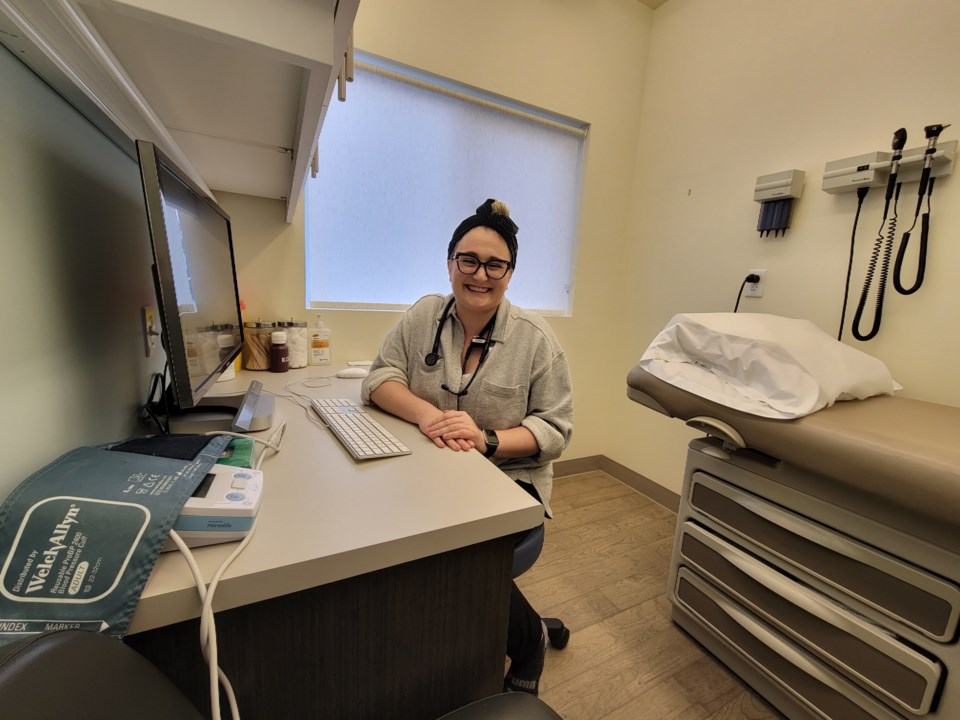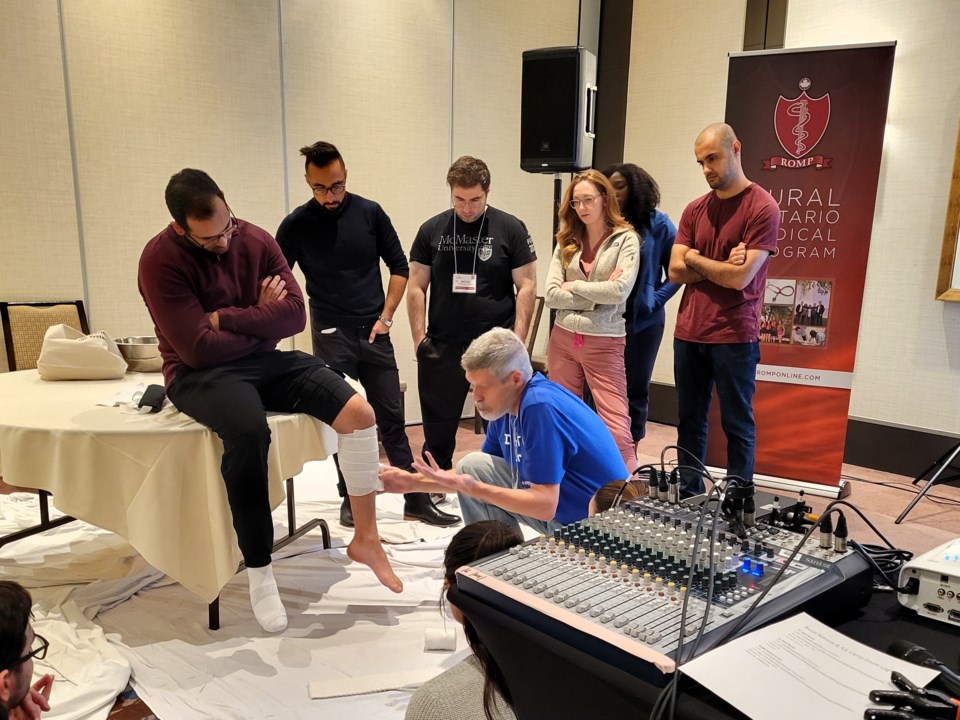Almost devoid of meaning from frequent repetition, the term "doctor shortage" is a painful reality in the southern Georgian Bay area where about 7,000 residents do not have a local family doctor.
Among those thousands are people like expectant mother and Collingwood resident Lauren Heide, who still sees her doctor in Tillsonburg, a town she moved away from four years ago.
Heide said her doctor in Tillsonburg is nearing retirement, but she can't find a local doctor taking on new patients.
“Where am I going to go for my baby’s check-ups?” she said. "I have no idea what to do."
Barbara Wade, a 71-year-old resident of Thornbury, has been driving back to Toronto for appointments for herself and her husband since moving to the community six years ago.
“I couldn’t get in with anybody, not even waiting lists,” she said. “They were full and they weren’t taking any new patients.”
It's not a sustainable health-care plan for Wade and her husband, or any of the large demographic of seniors without a family physician close by.
“I think the situation is pretty deplorable,” she said.
The South Georgian Bay Ontario Health Team estimates there are between 6,000 and 7,000 people in South Georgian Bay who currently do not have a local family doctor.
The Ontario College of Family Physicians estimates that by 2026, one in four residents throughout Ontario will be without a family doctor.
Municipalities within the southern Georgian Bay area – Collingwood, Clearview Township, Wasaga Beach and Town of the Blue Mountains – are all trying to attract new doctors to their areas a little bit differently.
However, the narrative emerging from current doctors and the associations that represent them is that becoming a family doctor is an unaffordable career choice.
‘Significant inequities of pay'
Dr. Mark Bonta, a specialist in internal medicine at CGMH, said the impacts of the doctor shortage in southern Georgian Bay are hitting the hospital, with increased visits to the emergency room.
According to the most recent Ontario auditor general’s report, one in five emergency visits across Ontario involved patients going to emergency for non-urgent issues because they didn’t have a family doctor or access to other services.
“The [limited] access to primary care does send some people to emergency,” said Bonta, noting that many people who moved to the area during the pandemic still haven’t found a local doctor.
“People are no longer choosing family medicine out of medical school; they’re choosing to specialize. Family medicine has a type of burn-out,” he said. “You’re running a small business with high overhead.”
Bonta said hospital practice is more attractive for people who want a better work-life balance, with a set schedule and less administration and paperwork, and better pay.
“It’s remuneration. Family doctors are paid less than specialists for the work they do. The training for family doctors is two years shorter than other specialties, but there are significant inequities of pay. The compensation hasn’t increased over time," said Bonta.
Municipalities have taken some initiative to recruit doctors with incentives meant to make the job more attractive, but whether that will bring the four to six new family doctors per year to the region that the South Georgian Bay Family Health Team estimates are needed is yet to be seen.
Wining and dining
Clearview Township offers subsidized rent to physicians who set up a practice at the Creemore Medical Centre.
Collingwood set aside $14,000 a year for five years to attract a specific doctor to Collingwood who had expressed interest.
The Town of Wasaga Beach offered new doctors space in a new medical building and $100,000 in incentives for up to four physicians spread over four years, funded through Wasaga Beach’s share in revenues from the Wasaga Playtime Casino.
The Town of The Blue Mountains has set aside $50,000 for physician recruitment in 2024.
Blue Mountains Coun. June Porter, a former nurse, served as chair of the South Georgian Bay Physician Recruitment Committee – comprised of mayors and staff from the four municipalities – until it was disbanded in 2022, and said recruitment tactics have grown from trying to attract a doctor to a town to recruiting them to the region.
“Family physicians have more opportunity in an acute care hospital than they would in Toronto or London. We do have an advantage,” said Porter. “There is no single magic bullet.”
She notes that in-kind incentives can also make a big impact, such as equipment costs being covered, decreased rental fees, affordable homes and an option to ease into the practice.
“The incentives need to be flexible. One size doesn’t fit all,” she said.
During a presentation to The Blue Mountains council in November 2023, Robert Johnston, director on the board for the Northeast Grey Health Clinics, urged municipal officials to get more involved with physician recruitment, and warned them that the shortage was probably going to get worse.
Usage of the emergency room at the hospital in Meaford has jumped by 26 per cent between 2021 and 2023, and that pressure is coupled with an aging demographic of family physicians. Johnston said 27 per cent of family physicians in the region are at least 60 years old, some were older.
Municipalities aren't the only forces working on physician recruitment.
Two physician open houses in 2023 organized by the South Georgian Bay Family Health Organization helped two doctors decide to set up practices in Wasaga Beach and Collingwood.
“We kind of wined and dined them, showed them around, took them up to Blue Mountain, and took them to see clinics that are looking for extra doctors and have space,” said Dr. Gillian Brakel, one of the organizers of the open houses and a family doctor in Wasaga Beach.
Brakel noted that under provincial rules, when a physician sets up shop in any of the four South Georgian Bay municipalities, that doctor must take patients from anywhere in South Georgian Bay from the South Georgian Bay Family Health Team’s wait list. The average roster size for a family doctor is between 800 and 1,200 patients.
While there are financial and in-kind incentives in the region, doctors coming out of medical school and residency say the incentives may not be enough to compensate for a government fee structure in need of updating.
‘You come away with $10/hour’
Student and newly graduated doctors congregated at Blue Mountain Conference Centre this month for the annual Rural Ontario Medical Program (ROMP) retreat on Feb. 23, where they met recruiters hoping to help the new doctors choose a municipality for their practice.
But like any career, pay rates rank high on the list of considerations.
For Ottawa-born Kirsten Mooney and Afghanistan-born Maghsod Ekhlas, both first-year residents at Western University's Hanover campus, the idea of more temporary, and higher-paid work at the start of their career is appealing.
A locum, for example, is a well-paid and temporary (from a couple of weeks to a couple of months) position at a hospital or medical practice offered to many new grads who can fill in while other doctors take holidays, or who can go to a community that doesn't have a full-time physician.
“My thing is, I have a husband and children who still live in Ottawa. I’m debating whether I’ll do locums for a bit until they graduate, and then settle, or should I settle but then probably never leave,” said Mooney.
If she does set up a practice, Mooney said she’ll be considering what a municipality has to offer her whole family such as employment opportunities for her husband, day cares, schools and whether there are gyms or athletic opportunities.
The idea of starting off with locums appeals to Ekhlas as well, and not just because he likes to travel and visit new communities.
“After learning about how a family practice is run – it’s not just the medicine you have to learn. You have to be a lawyer, an accountant, you have to know business. That’s what’s pushing me toward locums,” said Ekhlas.
Both Mooney and Ekhlas say financial incentives offered by municipalities will play into their decisions about where to set up a practice. However, they have to be significant. Mooney said $20,000 won’t even cover the interest on her student loans.
“We’re learning about all the fee codes through which we’ll get paid... they’re all so low,” she said.
“I think the government has to change the root of the problem. It is scary coming in thinking, you make $100 an hour. Half of it is taxed. Forty per cent goes into overhead. So you come away with $10 an hour. People assume doctors make so much money,” said Mooney.
“When you come in and see the reality – it’s not what we thought it was going to be,” she said.
Mooney said the provincial government pays doctors the same, regardless of whether they practice in a rural or urban area, but that rural doctors are expected to do more such as hospital rotations or home visits in addition to running a family practice.
“That’s why rural is suffering first,” she said.

Sudbury native Helene Bouchard, a new doctor who attended the ROMP retreat, said she thinks incentives do play a large role in doctor recruitment.
She chose to set up her practice in Elliott Lake eight months ago because she has family there and the municipality had a big need for emergency coverage. She said Elliott Lake offered incentives such as cash, housing, golf and ski memberships, which also played into her decision.
Retreat attendee and medical resident Sherif El Meniawy, grew up in Oakville and attended medical school in Ottawa.
El Meniawy said he considered both Grimsby and Collingwood for his residency, but ultimately decided on Grimsby because it’s closer to his family. He does rotations in Collingwood as an elective.
“Grimsby takes two residents. My fiancee is the other one,” he said. “We’re looking for a community that would take us both.”
After residency, El Meniawy said several factors will influence his decision on where to practise medicine, specifically what the practice is like in a community and proximity to Oakville.
Loan forgiveness and other financial incentives may also play a role, but they don't take away his concerns about the burden of business ownership a family doctor faces.
“The pay, paperwork and responsibility doesn’t make it as worth it as our credentials and skills allow us to do in a hospital,” he said. “It’s definitely a thing that a lot of family medicine residents think about. There is no shortage of people complaining about it.”
Physician recruiters at the ROMP retreat suggest a switch in focus from recruitment to retention. Corry Dobbin of Sauble Wiarton MD Quest and Chenelle Knapp of Chesley Physician Recruitment said financial incentives can't be all the eggs in the basket.
“We’re finding, for new physicians, it’s not just about money," said Dobbin. “At the beginning of their careers, they’re looking for support."
Dobbin said when trying to attract new doctors to a specific area, there should be more of a focus on who the doctor may be bringing with them, so thinking about employment for their spouse, daycare, schools and moving costs should be part of the equation. It’s an experience he knows personally, as his husband is a doctor in Wiarton and he found his own family making such a decision 15 years ago.
“That was our big concern. We knew we could go to any community and my husband could work. The question was, could I build a life in that community?” he said.
He also noted that more work should be done so doctors accredited in other countries can be accredited in Canada faster.
“The burden to get licensed here is insurmountable for a lot of them so they move on to other careers,” said Dobbin.
‘A financial formula doesn’t really cut it’
Peter Wells, the founder of the ROMP, started the program in 1988 in Collingwood, in an effort to get more doctors into rural communities. The program's premise is to place more medical residents in rural areas so they consider smaller communities when they are looking to set up a practice.

“After a rural background – like coming from a community – the next strongest factor associated with choosing rural practice, or being in a smaller community, is actually having experience there. That’s done through training,” said Michelle Hunter, managing director with the ROMP.
As of the end of 2023, approximately 74 physicians currently working in the South Georgian Bay area were trained through the ROMP in South Georgian Bay.
In 2023, 123 people did placements through the ROMP in South Georgian Bay.
“If you do your residency in a small town...we have about a 70 per cent retention rate that they stay and practise,” said Hunter, noting that number jumps to about 80 per cent in Collingwood.
From Hunter’s perspective, financial incentives provided by municipalities don’t work. She said in situations where the doctor has to stay for four years to get the funding, the doctors are leaving the community as soon as four years is up.
“Over and over again, we see that incentives don’t work," she said.
Hunter said municipalities instead offering space in medical buildings and help with housing would be more successful at recruiting and retaining doctors.
“We need to find a way to stabilize housing for these learners,” she said. “A financial formula doesn’t really cut it.”
‘A shared task’
One doctor who followed the ROMP residency pathway and who now has a family practice at Creemore Medical Centre, did benefit from a variety of incentives, but was also driven by a long-time desire to be a rural family doctor.
Dr. Alex Pearce, who grew up in Kitchener-Waterloo, works full days between the Collingwood General and Marine Hospital, her Creemore practice, and house calls.

“I went into med school knowing that I wanted to be a rural family doctor,” Pearce said. “I really like that you can do a little bit of everything and have a well-rounded scope of practice.”
She took over her practice from a retiring doctor in June 2022.
Pearce said the subsidized rent she pays to work out of the municipally-owned Creemore Medical Centre helped encourage her decision.
“It’s really expensive to set up a practice from scratch,” she said.
Pearce said she currently is paid $37 per patient per visit by the government, regardless of the number of issues that patient brings up. That money is used to pay rent, staff and office expenses, so Pearce says the take-home at the end of the day isn’t as much as people may think.
“Anything municipalities can do to make themselves stand out – it’s always going to be money related,” she said. “Family medicine is chronically underpaid.”
When asked how municipalities could best be attracting new family doctors to their communities, Pearce said she thinks they should be including doctors in that decision-making process.
“I think it’s a shared task. Our Ontario government has to do better to get people to want to be family doctors in the first place,” she said.
Residents of South Georgian Bay who do not have a family doctor are eligible to attend a nurse-practitioner led clinic at the Wasaga Beach Medical Clinic, open Tuesday and Thursday mornings, and to join the South Georgian Bay Ontario Health Team’s family physician wait list found through their website here.
— With files from Chris Fell



